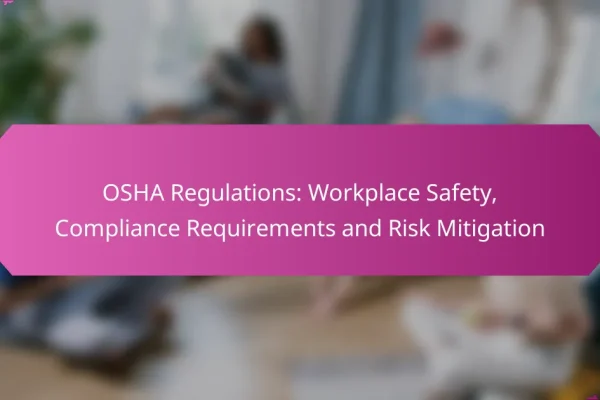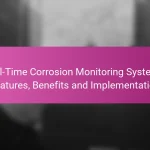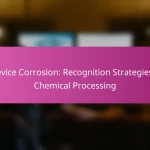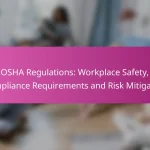What are the regulations for corrosion management in the United States?
In the United States, corrosion management regulations are primarily governed by federal standards and industry-specific guidelines. These regulations aim to minimize corrosion-related risks and ensure the safety and longevity of infrastructure and equipment.
Federal standards by OSHA
The Occupational Safety and Health Administration (OSHA) sets forth regulations that impact corrosion management, particularly in workplaces where employees may be exposed to corrosive substances. OSHA’s standards require employers to implement safety measures, including proper labeling, training, and protective equipment to mitigate corrosion risks.
Employers must also conduct regular inspections and maintenance to identify and address corrosion issues. Compliance with OSHA standards helps protect workers and maintain a safe working environment.
Industry-specific guidelines from NACE
The National Association of Corrosion Engineers (NACE) provides comprehensive guidelines for corrosion management tailored to specific industries. These guidelines include best practices for corrosion prevention, monitoring, and mitigation techniques that are essential for maintaining the integrity of structures and systems.
NACE’s standards, such as the NACE SP0169 for cathodic protection, offer detailed recommendations on materials, coatings, and inspection methods. Adhering to these guidelines can significantly reduce the risk of corrosion-related failures in various sectors, including oil and gas, transportation, and infrastructure.
State regulations overview
State regulations regarding corrosion management can vary significantly across the United States. Many states have adopted their own standards that align with or build upon federal regulations, focusing on specific local conditions and industries. For example, states with significant coastal infrastructure may have stricter guidelines due to higher corrosion risks from saltwater exposure.
It is crucial for businesses to understand their state’s regulations and ensure compliance to avoid penalties and enhance safety. Regularly reviewing state-specific guidelines can help organizations stay ahead of potential corrosion issues and maintain operational efficiency.
How do international standards impact corrosion management?
International standards play a crucial role in corrosion management by providing guidelines that ensure consistent practices across industries. These standards help organizations mitigate corrosion risks, improve safety, and enhance the longevity of materials and structures.
ISO standards for corrosion prevention
ISO standards, particularly ISO 12944, outline methods for protecting steel structures from corrosion in various environments. These guidelines cover aspects such as surface preparation, coating selection, and maintenance practices, ensuring that protective measures are effective and sustainable.
Organizations should assess their specific environments and choose appropriate ISO-compliant coatings and materials. For example, in coastal areas, using coatings that resist saltwater corrosion is essential to prolong the life of structures.
IEC guidelines for electrical equipment
The International Electrotechnical Commission (IEC) provides guidelines for corrosion management in electrical equipment, particularly in IEC 60068. These guidelines focus on the environmental conditions that can lead to corrosion, such as humidity and temperature variations.
To protect electrical equipment, it is vital to select corrosion-resistant materials and implement proper sealing techniques. Regular inspections and maintenance can help identify early signs of corrosion, allowing for timely interventions that prevent equipment failure.
What are best practices for compliance with corrosion management regulations?
Best practices for compliance with corrosion management regulations include implementing regular inspections, maintaining thorough documentation, and adhering to reporting requirements. These practices help organizations identify and mitigate corrosion risks effectively, ensuring safety and regulatory adherence.
Regular inspections and assessments
Conducting regular inspections and assessments is crucial for effective corrosion management. Inspections should be scheduled at least annually, but more frequent evaluations may be necessary for high-risk environments. Use standardized checklists to ensure all critical areas are examined, including pipelines, storage tanks, and structural components.
Employing advanced techniques such as ultrasonic testing or corrosion mapping can enhance the accuracy of assessments. These methods help detect early signs of corrosion and allow for timely interventions, potentially saving significant costs in repairs and replacements.
Documentation and reporting requirements
Thorough documentation is essential for compliance with corrosion management regulations. Maintain detailed records of inspections, assessments, and maintenance activities, including dates, findings, and corrective actions taken. This documentation serves as a vital reference for audits and regulatory reviews.
Reporting requirements may vary by region, so familiarize yourself with local regulations. Ensure that reports are submitted on time and include all necessary information to demonstrate compliance. Regularly review and update your documentation practices to align with any changes in regulations or industry standards.
What are the key organizations involved in corrosion management?
Key organizations involved in corrosion management include NACE International and ASTM International. These entities develop standards and guidelines that help industries effectively manage corrosion risks and ensure the integrity of materials and structures.
NACE International
NACE International, now known as the Association for Materials Protection and Performance, is a leading organization focused on corrosion prevention and control. It provides resources such as training, certification, and technical publications to help professionals understand and mitigate corrosion issues.
NACE develops industry standards that outline best practices for corrosion management, including guidelines for coatings, cathodic protection, and corrosion testing. These standards are widely adopted across various sectors, including oil and gas, infrastructure, and manufacturing.
ASTM International
ASTM International is another significant organization that creates voluntary consensus standards for materials, products, systems, and services. Its standards related to corrosion cover testing methods, material specifications, and performance criteria, which are crucial for ensuring the longevity of materials in corrosive environments.
ASTM standards are used globally and are essential for industries such as construction, automotive, and aerospace. By adhering to these standards, companies can improve their corrosion management strategies and enhance the durability of their products.
How can companies implement effective corrosion management strategies?
Companies can implement effective corrosion management strategies by establishing a comprehensive plan that includes risk assessments, control methods, and ongoing monitoring. This approach helps identify vulnerabilities and apply appropriate solutions to mitigate corrosion-related issues.
Risk assessment frameworks
Risk assessment frameworks are essential for identifying potential corrosion risks in various environments. Companies should evaluate factors such as material selection, environmental conditions, and operational practices to determine the likelihood and impact of corrosion.
Common frameworks include the use of Failure Mode and Effects Analysis (FMEA) and the Corrosion Risk Assessment (CRA) model. These tools help prioritize risks and guide the development of targeted management strategies.
Corrosion control methods
Corrosion control methods encompass a range of techniques designed to prevent or mitigate corrosion in materials. Common methods include protective coatings, cathodic protection, and material selection based on environmental compatibility.
For instance, applying a high-quality paint or epoxy coating can significantly reduce corrosion on metal surfaces. Additionally, using stainless steel or corrosion-resistant alloys in environments prone to moisture can enhance durability and longevity.
What are the costs associated with corrosion management compliance?
The costs associated with corrosion management compliance can vary significantly based on the industry and specific regulations. Key expenses typically include inspection, maintenance, and the use of specialized materials to prevent corrosion.
Budgeting for inspections
Regular inspections are essential for effective corrosion management and can incur substantial costs. Depending on the complexity of the assets, inspection costs can range from hundreds to thousands of dollars annually. It’s crucial to budget for both routine inspections and any necessary follow-up assessments.
When planning your budget, consider the frequency of inspections required by regulations or industry standards. For instance, some sectors may mandate annual inspections, while others might allow for longer intervals. Allocating funds for unexpected repairs following inspections is also wise.
Investment in corrosion-resistant materials
Investing in corrosion-resistant materials can significantly reduce long-term costs associated with corrosion management. While these materials may have a higher upfront cost, they can lead to savings by minimizing maintenance and replacement expenses over time.
When selecting materials, consider options such as stainless steel, galvanized coatings, or specialized polymers. The choice often depends on the specific environment and exposure conditions. For example, marine environments may require more robust solutions compared to industrial settings.
What emerging technologies are shaping corrosion management?
Emerging technologies in corrosion management focus on enhancing monitoring, prevention, and treatment methods. Innovations such as smart sensors and advanced coatings are leading the way in improving the longevity and safety of structures exposed to corrosive environments.
Smart sensors for monitoring
Smart sensors play a crucial role in corrosion management by providing real-time data on environmental conditions and material integrity. These sensors can detect changes in temperature, humidity, and chemical exposure, allowing for proactive maintenance and timely interventions.
For effective implementation, consider using sensors that are compatible with existing infrastructure and can communicate data wirelessly. Regular calibration and maintenance of these sensors are essential to ensure accurate readings and reliable performance.
Advanced coatings and materials
Advanced coatings and materials are designed to protect surfaces from corrosion by creating barriers that resist environmental factors. These coatings can include polymers, epoxies, and metallic layers, each offering different levels of protection based on the specific application and environment.
When selecting coatings, evaluate factors such as adhesion, flexibility, and resistance to chemicals and UV exposure. It’s important to follow manufacturer guidelines for application and curing to maximize the effectiveness of these protective materials.












